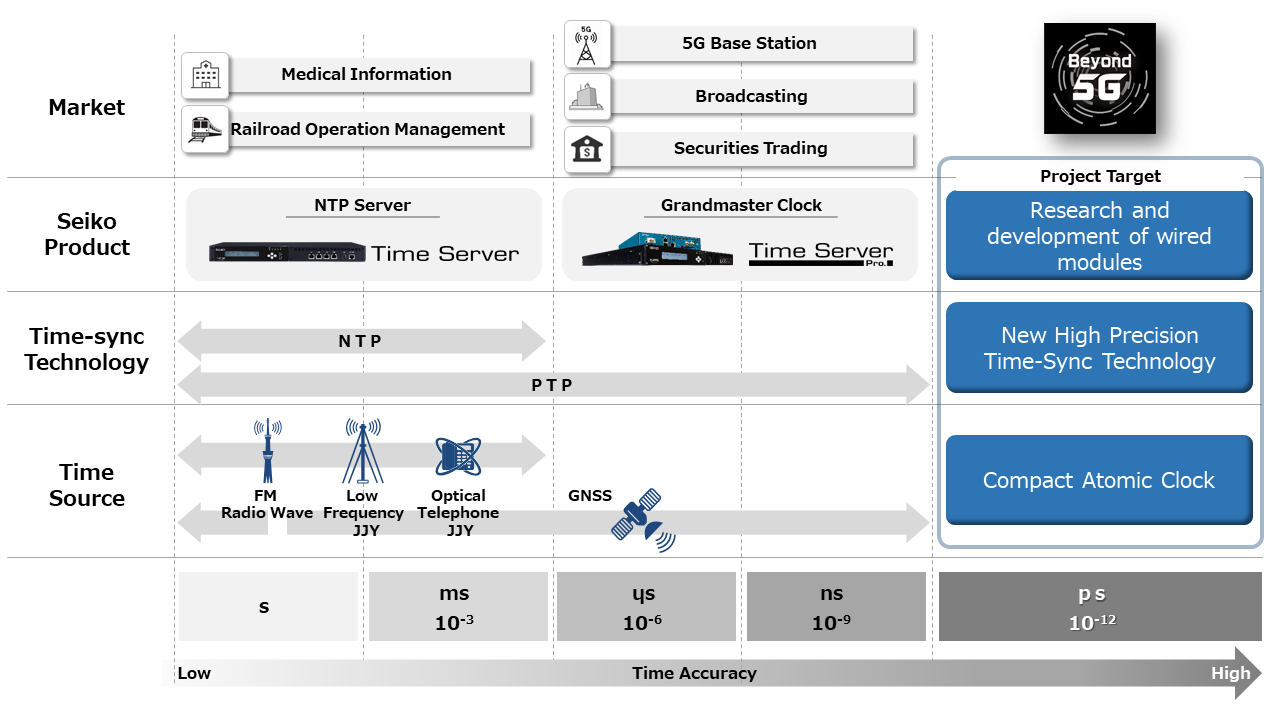Seiko Solutions Inc. (President: Mr. Jun Sekine, Head office: Chiba-shi, Chiba) submitted a joint proposal with the National Institute of Information and Communications Technology (NICT) and other organizations for research and development to expand radio frequency resources, which was newly implemented by the Ministry of Internal Affairs and Communications (MIC) in FY2022. We will start researching and developing wired time and frequency synchronization technology with a compact atomic clock.
The Network Time Protocol (NTP) for time synchronization and the Precision Time Protocol (PTP) for even higher precision time synchronization are now indispensable technologies for IT systems. The basic mechanism of these time synchronization protocols is to synchronize with the system’s most “accurate” clock (Master Clock), and a highly accurate Master Clock is essential to ensure synchronization accuracy.
Seiko Solutions has been developing high-precision NTP servers as the “Time Server series” for over 20 years, providing products that support a wide variety of time sources, including GNSS, which is widely used around the world, as well as Japan’s own time sources such as FM radio waves and standard-time and frequency-signal emission, JJY which is transmitted by the low-frequency band and telephone line. We have also provided PTP Grandmaster Clock (GMC) and have made significant contributions to the operation of financial, telecommunication, broadcasting, and other social infrastructures.
On the other hand, the conventional mechanism of synchronizing to a single master clock has been pointed out as a challenge in terms of its scope of application, reliability, power savings, and flexibility. For example, GNSS time synchronization can only be realized in an environment where the master clock that distributes time in the network can receive GNSS signals. Its reliability can be compromised by master clock malfunctions or spoofing. Although the grand master clocks that are widely available today are equipped with atomic clocks, the limitations of the PTP protocol mean that the actual time synchronization accuracy in the time domain is only about microseconds. The original high-time accuracy cannot be fully utilized. The time synchronization system using atomic clock chips proposed by NICT et al. eliminates these problems by constructing an autonomous decentralized synchronization system different from the master clock system and aims to build a time synchronization infrastructure with unprecedented accuracy that can be used safely when and where it is desired.
Our proposal for research and development of wired/wireless time and frequency synchronization technology with small atomic clocks has been selected for the realization of this time synchronization infrastructure.
Specifically, we will research how to realize a wired module equipped with a compact atomic clock that has the ability to compare time and frequency with multiple clocks, which is essential for autonomous decentralized synchronization, and develop a prototype of this module.
Seiko Solutions will continue to research and develop and provide optimal solutions to realize a time synchronization environment with the flexibility, robustness, high reliability, and energy efficiency required for sustainable social infrastructure.

*All product names mentioned herein are trademarks or registered trademarks of their respective companies.

